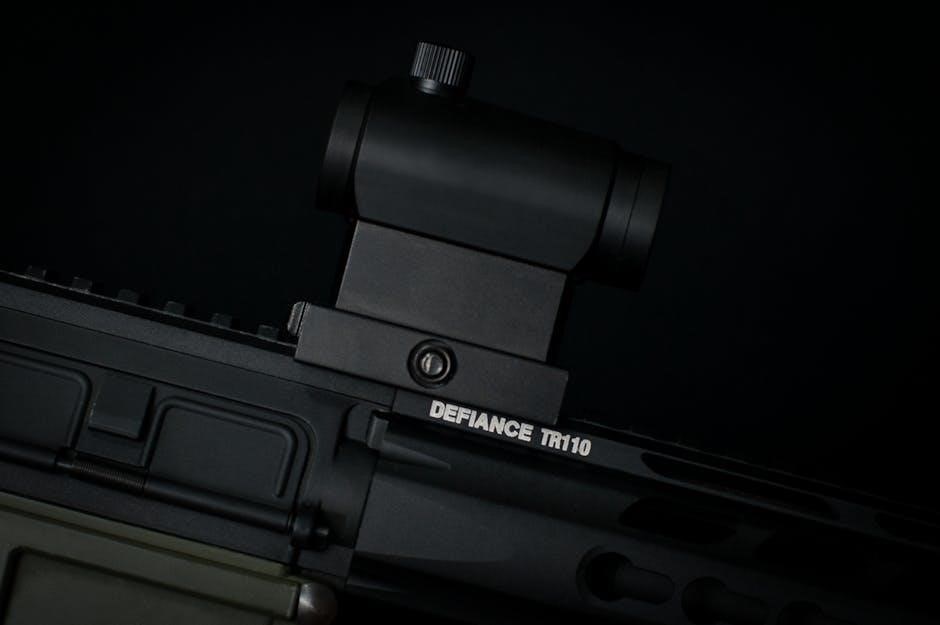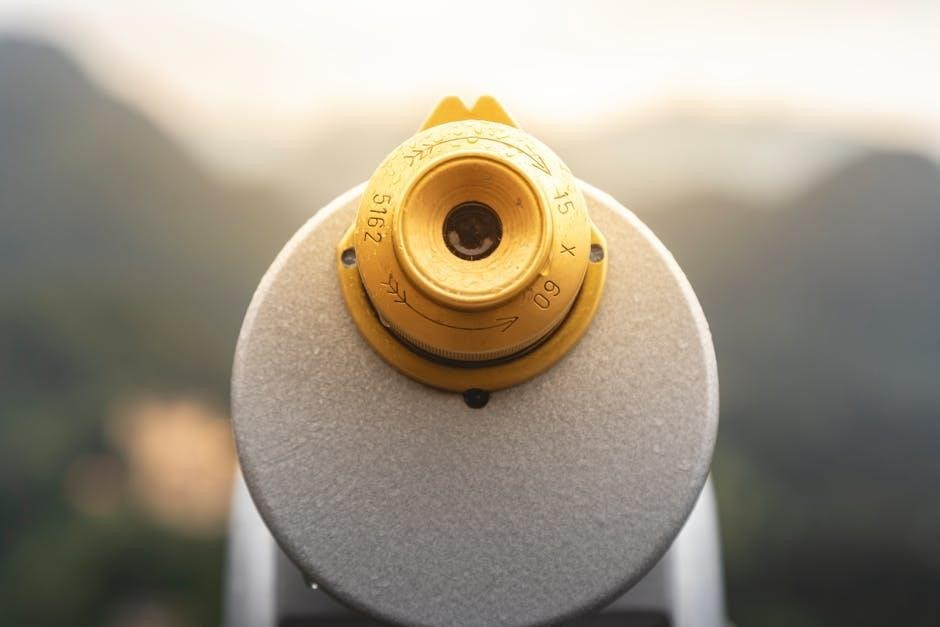William Optics guide scopes are essential tools for astrophotography, offering precision and reliability for capturing high-quality images. Their compact design and optical excellence make them ideal for guiding accuracy and ease of use, ensuring sharp and clear results in deep-sky imaging.
1.1 Overview of the William Optics Guide Scope
The William Optics guide scope is a specialized tool designed for precision astrophotography, offering a compact and lightweight solution for accurate star tracking. With its robust optical design and user-friendly features, it ensures sharp and clear images, making it an essential accessory for deep-sky imaging. Its portability and compatibility with various William Optics refractors enhance its versatility, providing amateur and professional astronomers with a reliable system for capturing stunning celestial details.
1.2 Importance of Guide Scopes in Astrophotography
Guide scopes are crucial for astrophotography, enabling precise tracking of celestial objects during long exposures. They minimize star trailing, ensuring sharper images. William Optics guide scopes, with their excellent optical clarity and durability, are particularly favored, offering reliability and stability. Their compatibility with popular astrophotography cameras and mounts further enhances their utility, making them indispensable for capturing high-quality deep-sky images with ease and consistency.

Key Features of the William Optics Guide Scope
William Optics guide scopes feature fully multi-coated optics for sharp images, lightweight designs for portability, and compatibility with William Optics refractors for seamless astrophotography setups.
2.1 Optical Design and Specifications
The William Optics guide scopes feature high-quality optical designs, including fully multi-coated lenses for enhanced light transmission and color correction. The UniGuide 50mm f/4 and Guide Star 61mm f/5.9 models offer excellent sharpness and clarity, with focal lengths of 200mm and 360mm, respectively. Their compact, lightweight constructions ensure portability while maintaining optical precision, making them ideal for astrophotography guiding. These specifications provide reliable performance for capturing detailed images of celestial objects.
2.2 Build Quality and Durability
William Optics guide scopes are known for their robust build quality and durability. Constructed with high-quality materials, they feature a sturdy design that ensures long-lasting performance. The UniGuide and Guide Star models include a Rotolock clamping system and helical focusing mechanism, which provide secure and precise adjustments. Their compact and lightweight design, weighing around 0.52kg, makes them easy to handle without compromising on stability. Additionally, the extra-long dew shield and CNC Slide-In Carry Handle enhance durability and functionality, ensuring reliable use in various astrophotography setups.
2.3 Compatibility with William Optics Refractors
William Optics guide scopes seamlessly integrate with their refractors, enhancing astrophotography setups. Designed to pair with models like the GT81 and RedCat 51, these guide scopes use a Slide-Base design for quick attachment to the CNC Slide-In Carry Handle. This compatibility ensures optimal performance, with features like the Rotolock system providing secure centring. The result is a streamlined system that simplifies guiding, allowing astrophotographers to focus on capturing sharp, high-quality images with minimal setup hassle.

Models of William Optics Guide Scopes
William Optics offers multiple guide scope models, each designed to meet specific astrophotography needs. Their lineup includes varying apertures and focal lengths, ensuring compatibility and versatility for precise guiding.
3.1 William Optics UniGuide 50mm f/4
The William Optics UniGuide 50mm f/4 is a compact and lightweight guide scope designed for astrophotography. It features a 50mm aperture and 200mm focal length, providing sharp images for precise guiding. Its air-spaced doublet lens ensures color correction and clarity. The UniGuide 50mm f/4 is compatible with William Optics refractors and includes a helical focusing mechanism for accurate adjustments. Its portability and durability make it a popular choice for amateur and professional astrophotographers seeking reliable performance in the field.
3.2 William Optics Guide Star 61mm f/5.9
The William Optics Guide Star 61mm f/5.9 is a versatile guide scope designed for astrophotography, offering a 61mm aperture and 360mm focal length. Its wide field of view and sharp optics make it ideal for selecting guide stars. The scope features a helical focusing mechanism, dew shield, and Rotolock clamping system for secure mounting. It is compatible with William Optics refractors and is favored for its portability and durability, making it a great choice for enthusiasts seeking precise guiding performance in deep-sky imaging.
3.3 Comparison of Different Models
William Optics offers several guide scope models, each tailored for specific needs. The UniGuide 50mm f/4 is compact with a 200mm focal length, ideal for portability. The Guide Star 61mm f/5.9 provides a wider aperture and longer focal length, enhancing guide star selection. Comparing these, the 61mm model offers better light gathering and a wider field, while the 50mm is lighter and more portable. Both deliver sharp optics and durability, making them top choices based on astrophotography preferences and equipment setup requirements.

Technical Specifications
William Optics guide scopes feature precise focal lengths and apertures, with models like the UniGuide 50mm f/4 and Guide Star 61mm f/5.9, ensuring optimal performance for astrophotography.
4.1 Focal Length and Aperture
The William Optics guide scopes offer varying focal lengths and apertures, such as the UniGuide 50mm f/4 with a 200mm focal length and the Guide Star 61mm f/5.9 with 360mm. These specifications ensure ample light-gathering capability and sufficient magnification for precise guiding. The aperture size allows for brighter images, making it easier to locate guide stars, while the focal length provides the necessary field of view for accurate astrophotography alignment and tracking.
4.2 Weight and Portability
William Optics guide scopes are designed to be lightweight and portable, with models like the UniGuide 50mm f/4 weighing approximately 0.52kg. This makes them easy to transport and mount without adding significant bulk to your astrophotography setup. Their compact design ensures they are travel-friendly, allowing astronomers to take their guiding systems on the go. The lightweight construction does not compromise durability, as they are built with high-quality materials to withstand regular use and transportation.
4.3 Additional Features (Dew Shield, Focusing Mechanism)
The William Optics guide scopes feature an extra-long dew shield to protect against moisture, ensuring clear views during long exposures. The helical focusing mechanism on the front lens allows for smooth and precise adjustments, maintaining focus stability. Additionally, the Rotolock clamping system provides a secure hold, ensuring accurate centering and alignment. These features enhance the overall usability and performance of the guide scope, making it a reliable choice for astrophotography enthusiasts.

Performance and Image Quality
The William Optics guide scope delivers sharp stars and clear images, ensuring precise guiding. Its wide field of view enhances accuracy, ideal for astrophotography sessions.
5.1 Sharpness and Clarity for Guiding
The William Optics guide scope excels in delivering sharp, clear images essential for precise guiding. Its fully multi-coated optics minimize chromatic aberration, ensuring stars remain pinpoint sharp across the frame. This clarity is vital for accurate autoguiding, reducing tracking errors and enhancing overall astrophotography results. Users consistently praise its ability to maintain focus stability, making it a reliable choice for capturing detailed celestial images with minimal distortion.
5.2 Wide Field of View for Guide Star Selection
The William Optics guide scope offers an expansive field of view, making it easier to locate and select suitable guide stars. This wide coverage enhances the guiding process, especially in densely populated star fields. Users appreciate the ability to find multiple guide stars quickly, ensuring stable and accurate tracking during long exposure astrophotography sessions. The wide field of view also simplifies framing and alignment, making the overall astrophotography experience more efficient and enjoyable.
5.4 Real-World Performance Reviews
Real-world reviews highlight the William Optics guide scope’s consistent performance in astrophotography. Users praise its ability to deliver sharp, clear images with precise guiding accuracy. Many note improved results in deep-sky imaging, with minimal star trailing and excellent stability. The wide field of view and robust build quality are frequently commended. Overall, users express satisfaction with its reliability and effectiveness, making it a trusted tool for achieving professional-grade astrophotography results under various conditions.

Comparison with Other Guide Scopes
William Optics guide scopes excel in optical quality and durability compared to competitors like Svbony and Askar, offering sharper images and wider fields of view for precise guiding.
6.1 Svbony 50mm Guide Scope
The Svbony 50mm guide scope is a budget-friendly option with a compact design, suitable for basic astrophotography needs. It features a 50mm aperture and f/4 focal ratio, providing decent light-gathering capabilities. While it may lack the premium build quality of William Optics models, it offers good value for hobbyists. Reviews highlight its ease of use and portability, making it a popular choice for those new to autoguiding. However, some users note limitations in sharpness compared to higher-end scopes.
6.2 Askar 32mm f/4 Guide Scope
The Askar 32mm f/4 guide scope is a compact and lightweight option designed for astrophotography guiding. It features a 32mm aperture and f/4 focal ratio, making it highly portable while still providing decent light-gathering capabilities. Constructed with ED glass, it delivers sharp images and minimal chromatic aberration. Its sturdy build and precise focusing mechanism are notable, though some users find the smaller aperture less effective for faint guide stars compared to larger models like the William Optics UniGuide 32.
6.3 Key Differences and Advantages
William Optics guide scopes excel due to their superior optical clarity and compatibility with William Optics refractors, offering precise guiding accuracy. Compared to alternatives like the Svbony 50mm, William Optics models often feature larger apertures and longer focal lengths, enhancing light-gathering and image sharpness. Their robust build quality and additional features, such as dew shields and precise focusing mechanisms, make them a preferred choice for astrophotographers seeking reliability and performance in deep-sky imaging applications.

User Reviews and Feedback
Users appreciate the William Optics guide scopes for their ease of use, image clarity, portability, durability, and sturdy build, though some note a learning curve for optimal performance.
7.1 General User Impressions
Most users are highly satisfied with William Optics guide scopes, praising their solid build quality, portability, and ability to deliver sharp, clear images. Many appreciate the ease of setup and use, making them ideal for both beginners and experienced astrophotographers. The compact design and lightweight construction are frequently highlighted as major positives. However, some users mention that the focusing mechanism could be smoother, and the weight, while manageable, may require careful balancing on smaller mounts. Overall, the feedback reflects confidence in their performance and reliability for guiding accuracy.
7.2 Specific Use Cases and Experiences
Many users have successfully paired William Optics guide scopes with their refractors, such as the GT81, for deep-sky imaging. The UniGuide 50mm f/4 is often praised for its portability and ease of use, while the Guide Star 61mm f/5.9 is favored for its wider field of view. Several photographers have reported excellent results when using these scopes with mounts like the EQ6-R, noting sharp guide stars and stable performance. A few users mentioned occasional focusing issues, but overall, the scopes have proven reliable for capturing high-quality astrophotography images.
7.3 Common Praises and Criticisms
William Optics guide scopes are frequently praised for their robust build quality, sharp images, and wide field of view, making them excellent for astrophotography. Users appreciate their portability and compatibility with various refractors. However, some critics mention that the focusing mechanism could be smoother, and the weight, while manageable, may require additional support in certain setups. Overall, the scopes are well-regarded for their performance and value, despite minor ergonomic quirks.

Accessories and Compatibility
William Optics guide scopes come with accessories like dew shields and helical focusers, ensuring optimal performance. They are compatible with William Optics refractors and third-party adapters.
8.1 Included Accessories
The William Optics guide scope comes with a range of essential accessories to enhance functionality. A durable dew shield protects against moisture, while the helical focusing mechanism ensures precise adjustments. The Rotolock clamping system provides secure and centered mounting, reducing slippage during use. These accessories are designed to optimize performance and convenience for astrophotographers, ensuring a seamless guiding experience with minimal setup hassle. Each component is crafted with quality materials, reflecting William Optics’ commitment to excellence in astronomy equipment.
8.2 Compatibility with William Optics Telescopes
William Optics guide scopes are specifically designed to work seamlessly with their refractor telescopes, such as the GT81, GT71, and RedCat series. The Slide-In Carry Handle and CNC Slide-Base design ensure secure mounting and compatibility. This integration allows for efficient guiding without slippage or alignment issues. The guide scopes are optimized to pair perfectly with William Optics refractors, making them a reliable choice for astrophotographers seeking precise control and ease of use with their existing setups.
8.3 Third-Party Adapter and Mounting Options
For users with telescopes from other brands, William Optics guide scopes are versatile and compatible with third-party adapters. The Rotolock clamping system allows precise centering, while optional adapters enable mounting on various telescope models. This flexibility ensures the guide scope can be integrated into different setups, offering wide compatibility and convenience for astrophotographers using equipment from multiple manufacturers, enhancing its utility beyond William Optics products.

Astrophotography Performance
The William Optics guide scope delivers exceptional guiding accuracy and stability, ensuring sharp star images across frames. Its wide field of view enhances guide star selection, optimizing deep-sky imaging results.
9.1 Guiding Accuracy and Stability
The William Optics guide scope excels in providing precise guiding accuracy, ensuring minimal star drift and consistent tracking. Its robust mechanical design enhances stability, even during long exposures, making it reliable for capturing sharp, clear images in astrophotography. The helical focusing mechanism allows for fine adjustments, maintaining focus accuracy throughout imaging sessions. Users report excellent performance, with stable guiding that supports high-quality results in deep-sky photography.
9.2 Use with Popular Astrophotography Cameras
The William Optics guide scope is compatible with popular astrophotography cameras like the ZWO ASI294MC Pro and ASI533MM Pro. Its helical focusing mechanism ensures precise focus control, while the wide field of view makes guide star selection easier. The guide scope’s design allows for seamless integration with various camera setups, providing sharp, clear images and reliable tracking. Users report excellent performance when paired with these cameras, enhancing their deep-sky imaging results significantly.
9.3 Deep-Sky Imaging Results
The William Optics guide scope excels in deep-sky imaging, delivering sharp stars and detailed nebulae. Its wide field of view aids in capturing expansive celestial objects, while the helical focusing mechanism ensures precise focus control. Users report excellent results when imaging nebulae and galaxies, with the Guide Star 61mm model particularly praised for its ability to handle long exposures. The guide scope’s performance enhances the overall quality of deep-sky images, making it a valuable tool for astrophotographers seeking professional-grade results.

Price and Value
William Optics guide scopes are affordably priced, offering excellent value for their quality and performance. Models like the UniGuide 50mm and Guide Star 61mm are competitively priced, ensuring cost-effectiveness without compromising functionality, making them a wise investment for astrophotographers seeking reliable guiding solutions.
10.1 Price Range and Availability
William Optics guide scopes are priced between $150 to $300, depending on the model and specifications. The UniGuide 50mm and Guide Star 61mm are widely available through the official William Optics website, astronomy specialty stores, and online retailers like Amazon and eBay. Their competitive pricing makes them accessible to both hobbyists and professional astrophotographers seeking reliable guiding solutions without breaking the bank.
10.2 Value for Money Compared to Alternatives
William Optics guide scopes offer excellent value, combining quality optics and durability at competitive prices. Compared to alternatives like the Svbony 50mm or Askar 32mm, William Optics models often provide better optical clarity and build quality for a similar or slightly higher cost. Their compatibility with popular telescopes and robust performance make them a cost-effective choice for astrophotographers seeking reliable guiding without compromising on image quality or functionality.
10.3 Warranty and Customer Support
William Optics guide scopes come with a comprehensive warranty, typically covering manufacturing defects for a period of up to 2 years. Their customer support team is known for being responsive and knowledgeable, assisting users with inquiries and issues promptly. This commitment to quality and service enhances the overall value proposition, ensuring customers feel confident in their investment for astrophotography needs.
The William Optics Guide Scope is a reliable and high-quality tool for astrophotography, offering excellent performance and value. Its reputation for precision and durability makes it a top choice for enthusiasts and professionals alike.
11.1 Final Thoughts on the William Optics Guide Scope
The William Optics Guide Scope is a standout option for astrophotography, delivering excellent optical quality, durability, and ease of use. Its robust design ensures long-term performance, while features like the helical focusing mechanism and dew shield enhance functionality. Users consistently praise its sharp imaging and wide field of view, making it ideal for guiding. With a strong warranty and reliable customer support, it offers great value for both enthusiasts and professionals seeking precise and stable astrophotography results.
11.2 Recommendations for Potential Buyers
Potential buyers seeking a reliable guide scope for astrophotography should consider the William Optics Guide Scope for its excellent optical performance and durability. For portability, the UniGuide 50mm f/4 is ideal, while the Guide Star 61mm f/5.9 offers a wider field of view for easier guide star selection. Both models integrate seamlessly with William Optics refractors and are backed by a solid warranty. Beginners and professionals alike will appreciate the value, build quality, and ease of use, making it a worthwhile investment for precise astrophotography results.
